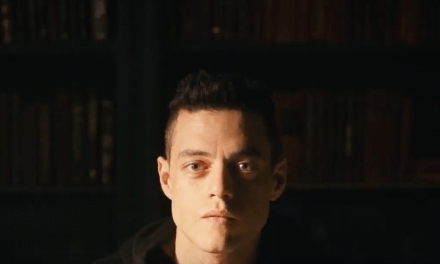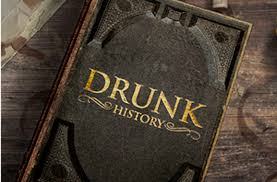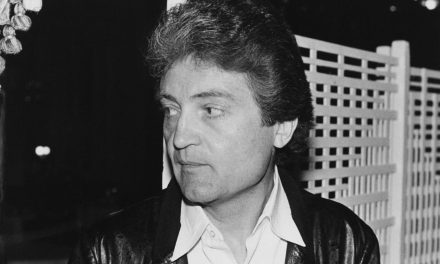WARNING – THIS BLOG CONTAINS SPOILERS.

I was pleased to see Anthony Smith and CST finally engage with what I’ve described elsewhere (slightly hyperbolically) as the televisual equivalent of Manet’s Le déjeuner sur l’herbe: True Detective. I agree with much of what Smith says about the pleasures of what he calls its genre uncertainty, but I want to take a different tack with it here in order to think about another puzzle which has occupied me over the past few years. That is the strange aversion in the field of television studies to what we might call the thing itself – television shows – even where, paradoxically, there is apparent direct engagement with them. A further prompt came with the publication at the start of the year of film historian Thomas Doherty’s piece ‘The Paratext’s the Thing’, where he tracks the oddity of the increasing engagement with ‘the satellite debris orbiting and radiating out from the core text’, those ‘unbilled extras… hogging the spotlight’, citing in particular the work of Paul Grainge and Catherine Johnson on interstitial materials, as well as US scholars Jonathan Gray and John T. Caldwell. As Doherty has it:
…old-school media scholarship always used what it called extra- (not para-) textual sources as lenses to bring the main text into clearer focus. The bits on the periphery were worthy of the critical intelligence only insofar as they illuminated the star attraction. The show was still the show. What all the paratextual critics have in common is that they are not particularly interested in individual television programs.
In conclusion he asserts that while industry and scholars seem thoroughly engaged with paratexts, the rest of us crave only the shows themselves remaining ‘firmly stuck in retro-textist mode’:
Oddly the rise of media scholarship dedicated to 15-second bits and freeze-framed logos is occurring just as the long-form serial drama has cemented its place as the main event in moving image art, a non-ephemeral format before which viewers seem quite willing to sit still for hour after hour. Perhaps, in jumping onto the wave of the future, the paratextual scholar may be ignoring the very real pleasures of the text to be had in the present.’
I have no doubt the paratextual work Doherty cites is valuable, rigorous and illuminating, but I find myself less and less inclined to read it. Sadly that goes for a lot of what today claims to be television studies, and hence I wonder in relation to Brett Mills’ earlier question whether I still ‘do’ television studies at all. I have Johnson’s book on Branding Television unread on my shelf, alongside Vicki Mayer’s Below the Line and a bunch of edited collections claiming to engage with Breaking Bad or Mad Men but which, on closer inspection seem to merely want to match up some slabs of socio-historical discourse to bits and pieces of the show that is putatively under scrutiny. There is undoubtedly fine writing and fine scholarship here and I don’t wish to question its status as such for a moment. The problem is with me, not them.
So, I find myself increasing drawn to any kind of criticism that is simply engaged with the work itself, however much it is also informed by the discursive and philosophical contexts in which that work emerges or can be understood. The art historian Michael Fried has become a touchstone in this respect, as has philosopher Robert Pippin’s recent work on aesthetics, film noir and the western. With a few exceptions, I rarely go to television studies scholarship any more to read for pleasure because the thing that made me want to study television is typically occluded or de-centred there. For me, industrial studies of television can only be interesting if they include the special fact that an aesthetic object is its primary outcome – something expressive and intended by human agents, rather than ‘constructed’ by, or somehow emanating from, discursive forces. I’m interested in thinking about television that is able to transcend its time and conditions of making, in television that is something we typically call art.
No doubt that makes me a pre-structuralist Arnoldian of some sort (a fact I’m more than comfortable with, by the way), but if you really want to peg my approach it would be a species of practical criticism, with close reading as its method. I would characterize my interest in television as articulating the value of the experience particular television shows provide. Christopher Ricks, whose career exemplifies the achievement and reach of this approach, cites William Empson’s account of why he sought to explain poetry in that way:
I felt sure the example was beautiful and that I had, broadly speaking, reacted to it correctly. But I did not at all know what had happened in this “reaction”; I did not know why the example was beautiful. And it seemed to me that I was able in some cases partly to explain my feelings to myself by teasing out the meanings of the text.
For Ricks what is important here is not that Empson wishes to show someone else that a poem is good but ‘to go some way toward showing how it comes to be good’. That’s an important fine-grained distinction, which means committing to the responsibility to account for why an artwork is the way it is, rather than corralling others to assent to your judgment. Ricks uses this Empson example in the opening pages of his magnificent book Dylan’s Vision of Sin where we can find this inspiring assertion:
What… is the critic’s enterprise? To give grounds for the faith that is in him, in us, in those of us who are grateful. It is a privilege.
From this to True Detective and Smith’s CST piece: he is surely right to note the pleasure of generic uncertainty that hits us on first viewing and I suspect this is where my reference to the impact of Le déjeuner sur l’herbe in my Screenaesthetics piece originated; on first viewing it is a beguiling and unsettling thing. However, once we know how the show ends and return to it as an artwork, what is the status of this uncertainty, how much can it continue to stand as an aspect of that show’s achievement? We don’t base our opinion exclusively upon our first-time responses to things as they unfold, although we may find them strangely echoed and repeated in subsequent encounters, even when the story is well known to us. Dylan’s haunting song, ‘Not Dark Yet’ is a great song on first hearing and its magnificence enlarges in subsequent encounters, not to mention the deepening prompted by the resonances Ricks discovers by reading it alongside Keats. Since I have seen True Detective a number of times now, let me offer some further thoughts leading to my reaction to a particular moment.
A central theme of the show is the hard work required in order to bring a chaotic and mysterious world into some kind of legible focus: this is articulated as a problem of paying sufficient attention, of knowing what that means in terms of one’s commitment to the world, and one’s work in that world. On one level this is clearly a skill foregrounded by the detective genre, where much can be made of what is noticed and what is missed. Episode five has one of the most extraordinary moves in the series because it begins to dismantle the careful patterning of present tense commentary by the two former cops, Marty Hart (Woody Harrelson) and Rust Cohle (Matthew McConaughey) during their interviews with detectives in relation to the past events of 1995 when they were a partnership hunting a serial killer. The episode begins with the resolution of that case – the putative killer is discovered – but we already know (or at least suspect) that a mistake has been made. That mistake is a very specific failure of attention, which is pinpointed in an earlier episode by a cut on the sound of a car horn, and which is only recollected very late in the final moments of the last episode, although it has been brought obliquely to our notice a little before then. And it is in this episode that Hart reflects in the present that, ‘My true failure was inattention.’ We take this to mean, as he says, that he failed to notice and attend to his wife and family, to that everyday world which was in plain sight. But as the show moves more solidly into the present tense in its final episodes we realize that this is not the only failure of attention. For what was in plain sight for us all along was the ordinary generic fact of True Detective as an example of the ‘buddy cop’ variant of the police movie, where two mismatched cops eventually transcend their differences in order to defeat evil. In these final episodes Hart, even though he is now a PI, learns to be the kind of cop that pays attention – working a hard case through the laborious searching through records, archives, databases and playing roles to mine information – that is to say, the kind of cop Cohle always had been.
This generic familiarity is overlaid with another generic motif, more obscure perhaps, but still striking in its eventual prominence: what Stanley Cavell calls (in The Pursuits of Happiness) the comedy of remarriage. These involve the generic feature whereby the couples depicted are primarily, through conversation and play, seeking ways to answer the moral question of how they should live their lives (together), to figure out ‘what kind of persons they aspire to be.’ True Detective hinges on the breakup of the buddy partnership sometime after the solving of the original case; subsequent episodes are about bringing them back together again. In the final moments we are treated to a near literal moment of ‘proposal’ where Hart hands the injured Cohle a gift tied up with a ribbon (in fact an elaborately wrapped packet of his favourite Camel cigarettes).

Shortly afterwards Cohle reveals he has experienced, while drifting in and out of consciousness after his injury, something close to a religious conversion, an encounter with ‘something deeper’. This is not, as Smith seems to suggest, the revelation that his previous nihilistic pessimism was a ‘front’ – I take it we need to accept that this is a genuine shift toward optimism that matches the ‘gradual unfolding’ of Hart’s coming closer to Cohle’s standards of attentiveness in his work. They find a way to realize their humanity, together, which means their acceptance of a world where they cannot defeat all evil and banish all injustice, but instead where what matters to them can be freely acknowledged and exchanged without deceit and no longer under the shadow of inevitable violence and degradation.
None of this is much of a critical revelation, but it finally gets me to the moment – the briefest of domestic vignettes – that more than any other instructed me to think about True Detective’s interest in the significance of attention. This occurs also in episode five as we glide through the years between 1996 and 2002 helped by Hart’s melancholy voice over. Suddenly we come to rest at home with Cohle and his partner Laurie (Elizabeth Reaser) sitting on the couch together in front of the television; she is clicking through the channels and, unseen, Cohle gradually turns his gaze toward her. What has awoken this scrutiny on his part? Can we read it in a ‘television studies’ way as a moment of gendered division, the inconstant female consumer seeking trivial pleasures, versus a unified male, dissatisfied with the realization of his domestic confinement? Perhaps, but perhaps also it is Cohle’s irritation at his own impatience with impatience, the sense that he cannot come to rest here in this restless moment; that this is a partnership where surfing stands in for conversation, or reflection; that this is the instant where he loses faith in their coupledom, their future. But Cohle says nothing in the brief moment we see, although we are free to imagine, as his older self has already told us, that the merciless nature of his criticism which finally broke them apart, found its first foothold in this emblem of television’s enduring failure to hold our gaze securely.

Jason Jacobs is Reader in Screen Aesthetics and Head of the School of English, Media Studies and Art History at the University of Queensland. He is author of The Intimate Screen and Body Trauma TV. His BFI TV Classic on Deadwood was published in July 2012. He is writing a book on David Milch for the Manchester University Press Television Series and is co-editor with Steven Peacock of the collection Television: Aesthetics and Style (Bloomsbury, 2013). He is currently working on an Australian Research Council funded project called ‘The Persistence of Television: how the medium adapts to survive in the digital world.’





